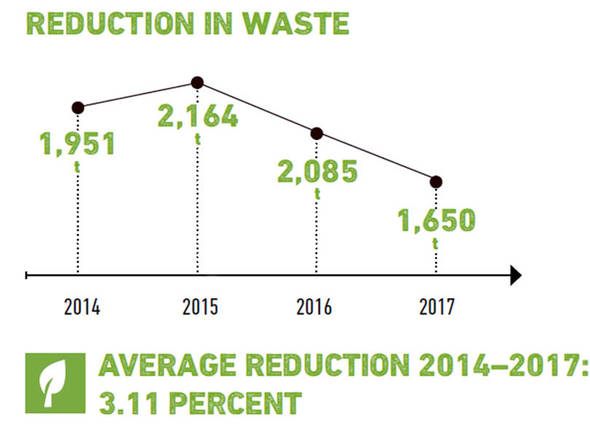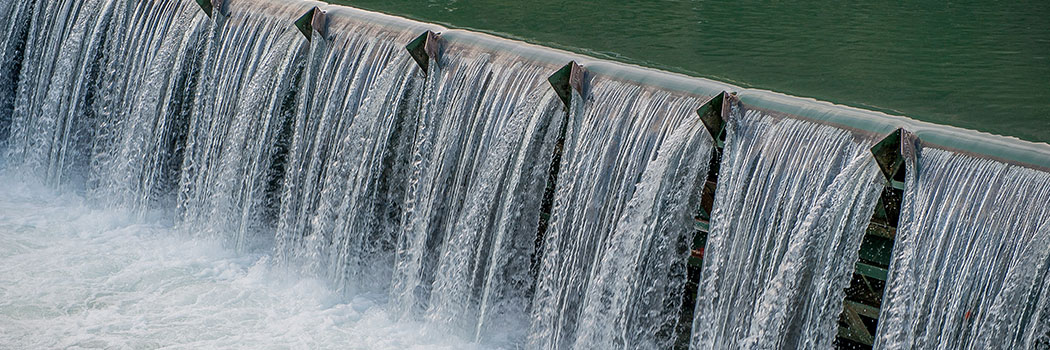Hydropower since 1898

BPW has been using renewable energy from hydropower for 120 years – the ‘Bergischen Achsenfabrik Wiehl’ hammer mill was powered by a water wheel in 1898. Today, a turbine generates electricity in its place – 282,000 kilowatt hours in 2017. This is equal to the annual electricity consumption of 85 four-person households. This could cover, for example, a fifth of the electricity required to power the EPD coating systems for surface finishing. BPW is currently thoroughly testing and overhauling the systems required for turbine operation. As a result, electricity purchases for 2018 are expected to total only around 60% of the previous year’s average output. This test will determine whether further compensatory measures – such as the pike used in 2016 – will be necessary in future to maintain the biological equilibrium in Obergraben.
Water – for added safety and efficiency

BPW not only uses water to generate energy, but also to cool production systems. The discharge of wastewater into public waters is audited externally by the regional wastewater association in addition to the company’s own monitoring. BPW therefore ensures that the wastewater quality and quantity complies with legal provisions.
With regard to the increased legal requirements for the certificate under Germany’s Water Resources Act [Wasserhaushaltsgesetz], additional training was held for the water protection officer and training sessions were held for 18 employees, including management staff with responsibilities in this regard. These training sessions were individually tailored to the relevant work area in the company to ensure appropriate handling of systems for the treatment of water-polluting substances.
BPW already began to replace the stock of analogue water meters with electronic meters in line with the Industry 4.0 standard back in 2017. These communicate with the MESSDAS monitoring system to identify optimisation potential and leaks more quickly. The stock of digital meters is gradually being expanded and an employee has been working on this as a primary responsibility since 2017.
Sustainability
Waste management: significant reduction in amounts of waste

BPW is working hard to prevent waste and increase recycling rates. In 2017, 435 tons of waste were saved, corresponding to a reduction of 20% compared to the previous year. For example, the company preventing the production of 125 tons of ceramic waste by discontinuing the use of submerged arc welding. The recycling rate was 69% – a decrease of 2% on the previous year. This was due to the fact that BPW prevented the generation of more recyclable waste than non-recyclable waste.
As an initiative to increase general recycling of waste, BPW is currently developing a new, reusable packaging system for deliveries to international subsidiaries. In order to reduce typical mixed waste from offices and break rooms, new waste separation containers were set up. BPW is also planning to introduce internal training on sorting waste.
BPW running gears almost fully recyclable

BPW’s running gears and components are already almost entirely recyclable. As a result, according to the latest material input analysis, the BPW ECO Air Compact running gear has a metal content that is 97.7 percent recyclable. With the high percentage of recyclable material in the axle systems it produces, BPW voluntarily takes responsibility beyond the service life of the products to downstream processes such as recycling and disposal.
Durability and repair-friendliness as a contribution to sustainability
Highly integrated, but inseparably connected assemblies are currently very popular in the automotive and commercial vehicle industry. But they cannot be repaired in the event of defects, but must instead be replaced and disposed of as a whole. BPW, on the other hand, continues to focus on excellent long-term quality and particularly on simple and inexpensive maintenance and repair of all its solutions and components. Such components ensure particularly low operating costs and a high vehicle resale value. For example, if the disc brake system is in need of repair, individual parts (e.g. caliper bearings and tappets) such as the brake piston can simply be replaced instead of having to dispose of the entire brake caliper. Uniform spanner gaps are used across the entire BPW running gear, so special tools are not required. When developing new components, BPW makes sure that they are backwards compatible. This means that axles over 40 years old can still be replaced with the latest components or repaired.
The BPW running gear’s new ‘digital DNA’ simplifies and accelerates maintenance and repair even further – a QR code on the axle displays all spare parts information on a smartphone in seconds, as well as videos with practical tips for the garage.

